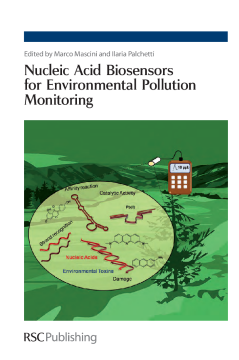
BOOK
Nucleic Acid Biosensors for Environmental Pollution Monitoring
Mehmet S Ozsos | A Erdem | Giovanna Marrazza | Ashok Mulchandani | Yi Lu | Jan Labuda | Kim R Rogers | Arben Merkoci | Marco Mascini | Ilaria Palchetti
(2011)
Additional Information
Book Details
Abstract
Nucleic acids are the fundamental building blocks of life and are found in all living things. In recent years, their functions have been shown to extend beyond the Watson-Crick base pair recognition of complementary strands. Molecules (known as aptamers) consisting of 40-50 nucleotides have been isolated that are able to bind a broad range of molecules with high affinity and specificity. The molecules recognized by aptamers range from small organic molecules to proteins, cells and even intact viral particles. Catalytic DNA molecules called NAzymes (RNAzyme or DNAzyme) have also been shown to exist and, when combined with aptamers, are known as aptazymes. These biomolecules can be used to develop smart and innovative biosensors for environmental analysis. Monitoring of contaminants in the air, water and soil is a key component in understanding and managing risks to human health and ecosystems. This, in conjunction with the time and cost involved in traditional chemical analysis, means there is a growing need for simple, rapid, cost-effective and portable screening methods. Biosensors are compact devices which complement current field screening and monitoring methods.
This book demonstrates the incredible opportunities that nucleic acids can offer to environmental analytical chemistry. The chapters: show how nucleic acids have a pivotal role in the development of smart biosensors for environmental monitoring; describe the development of biosensors based on aptamers and NAzymes for the detection of organic and inorganic pollutants; deal with the use of nucleic acid based biosensors for environmental toxicity screening, and detail the use of nanomaterials, as well as miniaturization and lab-on-a-chip technologies, for nucleic acid based biosensing systems.
Marco Mascini is a professor of analytical science in the Department of Chemistry at the University of Florence. He sits on the editorial board of several international journals and has been the coordinator and leader of several participant units in various European Projects.
Dr. Ilaria Palchetti received her degree in Pharmaceutical Chemistry and Technology from the University of Firenze in 1994 and a PhD in Biotechnology at Cranfield University in 1999. She is assistant professor of analytical chemistry in the Faculty of Sciences at the University of Florence. She has considerable expertise in biosensor development and in the environmental application of biosensors.
